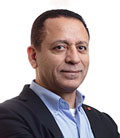How did asset utilization modeling save Sadara $1 B in capital cost?
Sadara is a JV between Saudi Aramco and Dow Chemical.
IP: 10.9.195.137
This is a preview of our premium content. Thank you for your interest—please
log in or
subscribe to read the full article.
The Authors
Hayek, F. - Sadara Chemical Co., Jubail Industrial City, Saudi Arabia
Fareed Hayek is a Senior Reliability Simulation Engineer at Sadara Chemical Co., specializing in RAM modeling and spare parts optimization. Previously, Mr. Hayek was a reliability and improvement engineer at Dow Chemical in Freeport, Texas. Prior to that, he was a senior reliability and maintainability engineer at NASA for the International Space Station (ISS) and the Space Shuttle programs. He received the Space Flight Awareness Honoree award for reliability and maintainability support of the ISS. He holds ASQ CRE and CMRP certifications. Mr. Hayek earned a BS degree in mechanical engineering from the University of Jordan, an MS degree in computer engineering from the University of Houston, and is a PhD candidate in industrial engineering at Mississippi State University.
Moran, M. - Sadara Chemical Co., Jubail Industrial City, Saudi Arabia
Marty Moran is a Senior Reliability Engineer at Sadara Chemical Co. He is trained as a chemical engineer and has more than 35 yr of experience in process industries. He has concentrated his career on using advanced computer technology in the areas of asset management/reliability, advanced process control and plant optimization. Mr. Moran holds a US patent for multivariable control. Prior to joining Sadara, he worked for AspenTech, Meridium, Continental Controls and Setpoint.
Related Articles
From the Archive








Comments